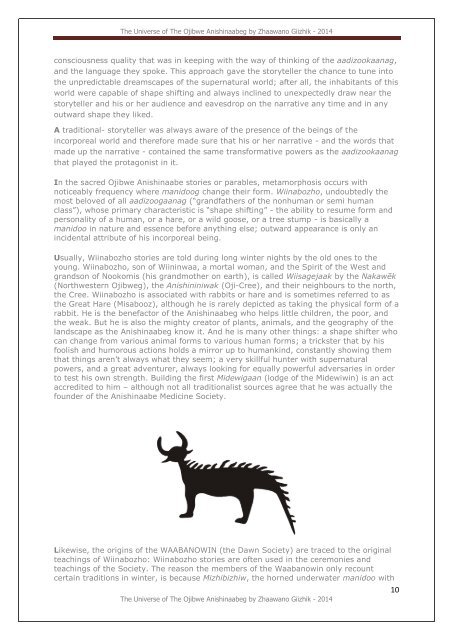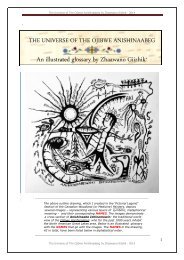The Universe Of The Ojibwe Anishinaabeg, an illustrated glossary by Zhaawano Giizhik*
A Glossary written and illustrated by Native Woodland artist Zhaawano Giizhik demonstrating a cross section of Anishinaabe Izhinamowin: the traditional worldview of the Ojibwe Anishinaabeg, who for the past 2 millennia inhabit the North American Great Lakes area.
A Glossary written and illustrated by Native Woodland artist Zhaawano Giizhik demonstrating a cross section of Anishinaabe Izhinamowin: the traditional worldview of the Ojibwe Anishinaabeg, who for the past 2 millennia inhabit the North American Great Lakes area.
You also want an ePaper? Increase the reach of your titles
YUMPU automatically turns print PDFs into web optimized ePapers that Google loves.
<strong>The</strong> <strong>Universe</strong> of <strong>The</strong> <strong>Ojibwe</strong> <strong>Anishinaabeg</strong> <strong>by</strong> Zhaaw<strong>an</strong>o Giizhik - 2014<br />
consciousness quality that was in keeping with the way of thinking of the aadizooka<strong>an</strong>ag,<br />
<strong>an</strong>d the l<strong>an</strong>guage they spoke. This approach gave the storyteller the ch<strong>an</strong>ce to tune into<br />
the unpredictable dreamscapes of the supernatural world; after all, the inhabit<strong>an</strong>ts of this<br />
world were capable of shape shifting <strong>an</strong>d always inclined to unexpectedly draw near the<br />
storyteller <strong>an</strong>d his or her audience <strong>an</strong>d eavesdrop on the narrative <strong>an</strong>y time <strong>an</strong>d in <strong>an</strong>y<br />
outward shape they liked.<br />
A traditional- storyteller was always aware of the presence of the beings of the<br />
incorporeal world <strong>an</strong>d therefore made sure that his or her narrative - <strong>an</strong>d the words that<br />
made up the narrative - contained the same tr<strong>an</strong>sformative powers as the aadizooka<strong>an</strong>ag<br />
that played the protagonist in it.<br />
In the sacred <strong>Ojibwe</strong> Anishinaabe stories or parables, metamorphosis occurs with<br />
noticeably frequency where m<strong>an</strong>idoog ch<strong>an</strong>ge their form. Wiinabozho, undoubtedly the<br />
most beloved of all aadizooga<strong>an</strong>ag (“gr<strong>an</strong>dfathers of the nonhum<strong>an</strong> or semi hum<strong>an</strong><br />
class”), whose primary characteristic is “shape shifting” - the ability to resume form <strong>an</strong>d<br />
personality of a hum<strong>an</strong>, or a hare, or a wild goose, or a tree stump - is basically a<br />
m<strong>an</strong>idoo in nature <strong>an</strong>d essence before <strong>an</strong>ything else; outward appear<strong>an</strong>ce is only <strong>an</strong><br />
incidental attribute of his incorporeal being.<br />
Usually, Wiinabozho stories are told during long winter nights <strong>by</strong> the old ones to the<br />
young. Wiinabozho, son of Wiininwaa, a mortal wom<strong>an</strong>, <strong>an</strong>d the Spirit of the West <strong>an</strong>d<br />
gr<strong>an</strong>dson of Nookomis (his gr<strong>an</strong>dmother on earth), is called Wiisagejaak <strong>by</strong> the Nakawēk<br />
(Northwestern <strong>Ojibwe</strong>g), the Anishininiwak (Oji-Cree), <strong>an</strong>d their neighbours to the north,<br />
the Cree. Wiinabozho is associated with rabbits or hare <strong>an</strong>d is sometimes referred to as<br />
the Great Hare (Misabooz), although he is rarely depicted as taking the physical form of a<br />
rabbit. He is the benefactor of the <strong>Anishinaabeg</strong> who helps little children, the poor, <strong>an</strong>d<br />
the weak. But he is also the mighty creator of pl<strong>an</strong>ts, <strong>an</strong>imals, <strong>an</strong>d the geography of the<br />
l<strong>an</strong>dscape as the <strong>Anishinaabeg</strong> know it. And he is m<strong>an</strong>y other things: a shape shifter who<br />
c<strong>an</strong> ch<strong>an</strong>ge from various <strong>an</strong>imal forms to various hum<strong>an</strong> forms; a trickster that <strong>by</strong> his<br />
foolish <strong>an</strong>d humorous actions holds a mirror up to hum<strong>an</strong>kind, const<strong>an</strong>tly showing them<br />
that things aren’t always what they seem; a very skillful hunter with supernatural<br />
powers, <strong>an</strong>d a great adventurer, always looking for equally powerful adversaries in order<br />
to test his own strength. Building the first Midewiga<strong>an</strong> (lodge of the Midewiwin) is <strong>an</strong> act<br />
accredited to him – although not all traditionalist sources agree that he was actually the<br />
founder of the Anishinaabe Medicine Society.<br />
Likewise, the origins of the WAABANOWIN (the Dawn Society) are traced to the original<br />
teachings of Wiinabozho: Wiinabozho stories are often used in the ceremonies <strong>an</strong>d<br />
teachings of the Society. <strong>The</strong> reason the members of the Waab<strong>an</strong>owin only recount<br />
certain traditions in winter, is because Mizhibizhiw, the horned underwater m<strong>an</strong>idoo with<br />
10<br />
<strong>The</strong> <strong>Universe</strong> of <strong>The</strong> <strong>Ojibwe</strong> <strong>Anishinaabeg</strong> <strong>by</strong> Zhaaw<strong>an</strong>o Giizhik - 2014





